Auckland West Coast Guide: Piha, Muriwai & Waitākere

Discover Auckland’s wild west coast. Visit Piha, Muriwai, and the Waitākere Ranges with walks, waterfalls, surf, and tips for an unforgettable day trip.
Auckland’s West Coast is a haven of untamed beauty just outside the city. Think black-sand beaches, lush rainforests, thundering waterfalls, and cliff-top vistas over the Tasman Sea.
In this tour guide, we’ll take you on a complete circuit through the highlights of the Waitākere Ranges and two famed west coast beaches: Piha and Muriwai.
This itinerary is crafted with international visitors in mind (with local tips sprinkled in) to showcase the best of Auckland’s wild side in a day or weekend trip.
You’ll start at the Arataki Visitor Centre for an introduction to the region, then venture to Piha Beach, renowned for its surf and nearby waterfall hike, before heading up to Muriwai Beach to marvel at a clifftop gannet colony and sweeping coastline.
Get ready for an adventure that’s equal parts sightseeing, walking, and pure Kiwi nature immersion.
Highlights of this West Coast adventure:
- Panoramic lookout points and cultural exhibits at Arataki Visitor Centre (gateway to the Waitākere Ranges).
- The dramatic Piha Beach with its iconic Lion Rock, crashing surf, and a hidden waterfall walk to Kitekite Falls.
- Rugged Muriwai Beach featuring miles of black sand and a rare mainland gannet bird colony perched on coastal cliffs.
Whether you’re an avid hiker, casual beach stroller, or photography enthusiast, Auckland’s west offers an unforgettable escape just 40–50 minutes from downtown.
Let’s dive into the itinerary - and don’t forget your walking shoes and camera!
Arataki Visitor Centre – Gateway to the Waitākere Ranges
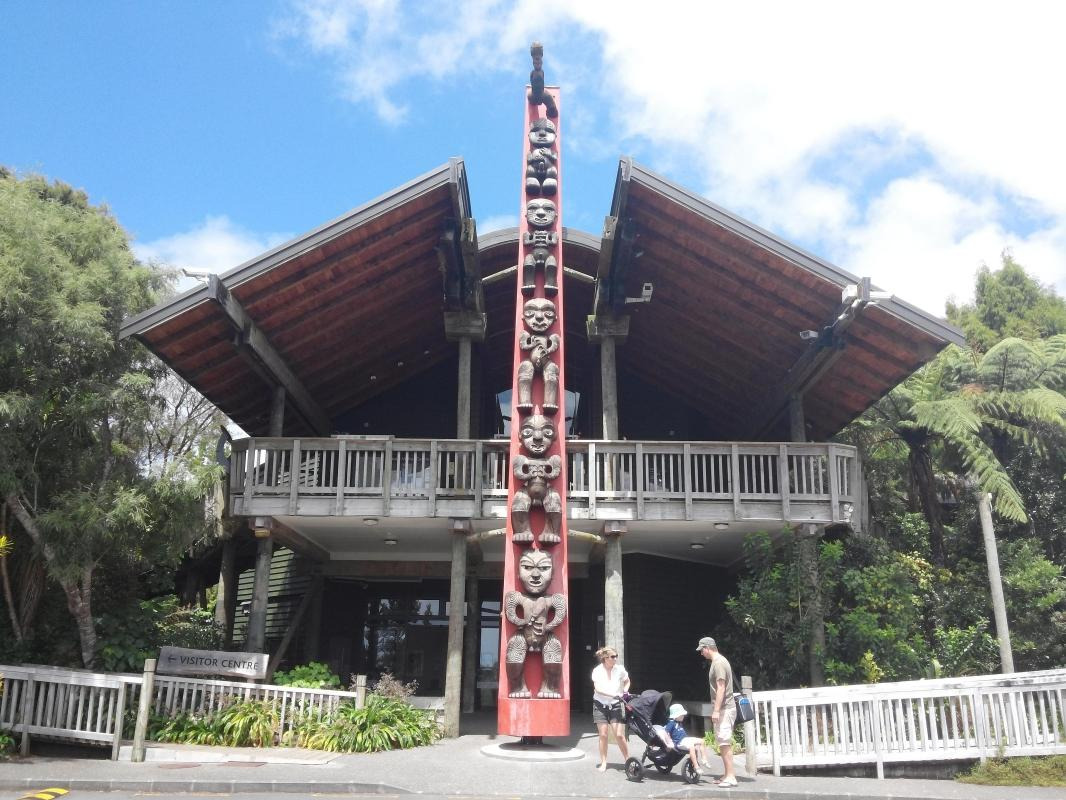
Located only about a half-hour’s drive from central Auckland, the Arataki Visitor Centre is the perfect starting point for a west coast adventure. Perched in the Waitākere Ranges Regional Park, this visitor centre offers sweeping lookouts across dense native bush, with views stretching out to both of Auckland’s harbours on a clear day (Waitematā to the east and Manukau to the south). Step onto the viewing deck and you’ll immediately get a sense of the lush rainforest and rugged terrain that define the ranges.
Inside the centre, you’ll find interactive exhibits on New Zealand’s native wildlife, forest ecology, and Māori cultural heritage. It's a great way to learn about the area’s flora, fauna and history. Friendly staff or park rangers are on hand; it’s worth chatting with them for trail advice or local insights before you hit the tracks. They can update you on any track closures or safety notices – important because parts of the Waitākere Ranges have been periodically closed to protect kauri trees from disease.
You’ll also spot magnificent Māori carvings at Arataki’s entrance, symbolically guarding the forest - a fantastic photo op and cultural touchpoint.
Practical tip: Arataki has free entry, restrooms and picnic areas, so it’s an ideal pit stop to refresh and get oriented. There’s a short nature walk near the center as well, if you want to stretch your legs right away. And if you haven’t already, this is your chance to grab snacks or water in nearby Titirangi village – the west coast beaches themselves have limited shopping options. With a panoramic preview and map in hand, you’re ready to dive deeper into the rainforest and beyond!
Piha Beach – Black Sand Surf and Waterfalls
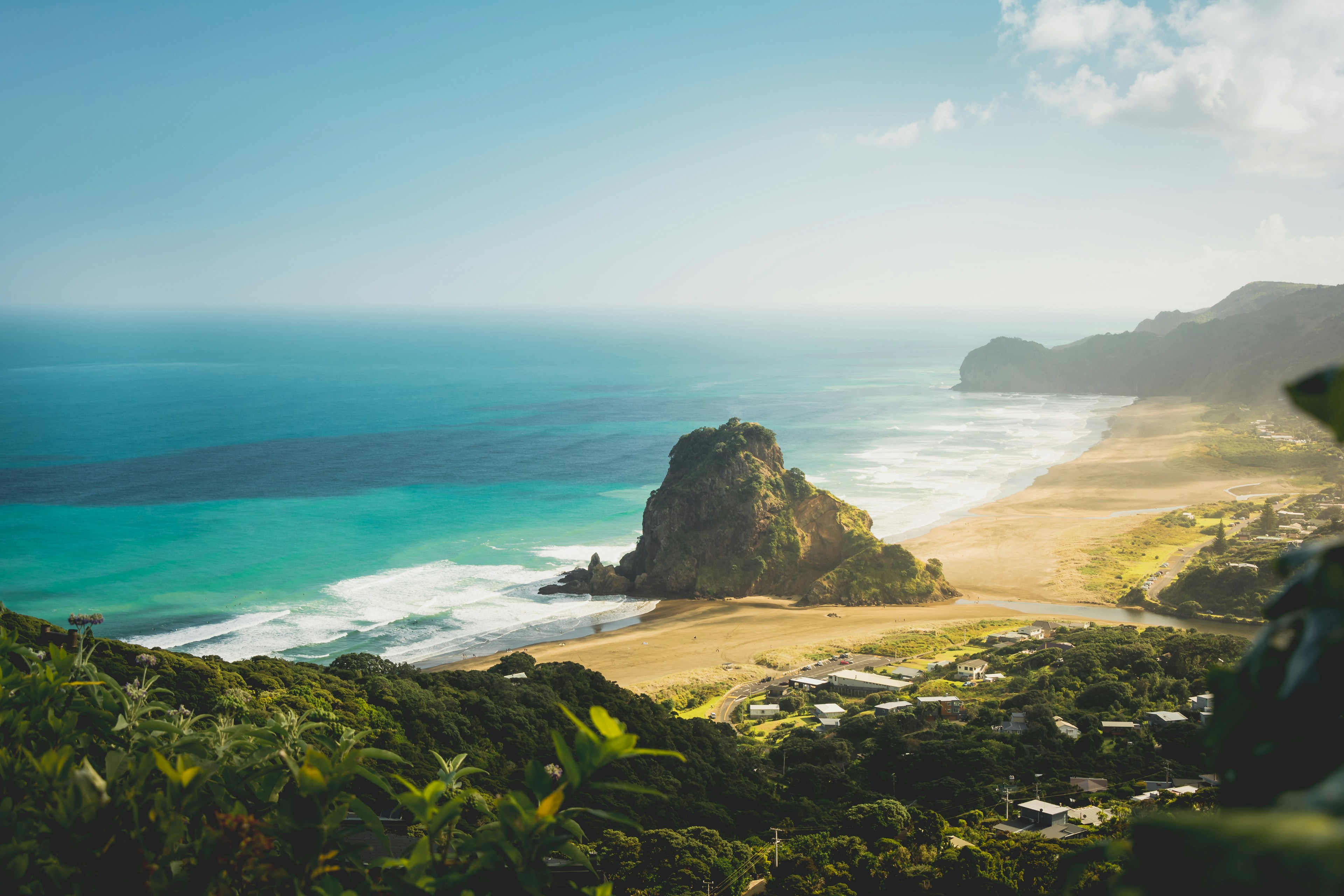
After Arataki, continue west over winding mountain roads to Piha Beach, approximately 45 minutes from Auckland’s city center. As you descend toward the coast, you’ll catch sight of Lion Rock, the huge lion-shaped rock formation jutting from Piha’s shoreline. Piha is one of Auckland’s most iconic coastal destinations, famed for its wild surf, volcanic black sands, and dramatic scenery. Upon arrival, take a moment to feel the unique black sand underfoot - its color comes from iron-rich volcanic minerals, and it can get quite hot under summer sun, so keep those shoes handy!
This beach is beloved by surfers for its powerful waves, and even if you’re not surfing yourself, it’s fun to watch locals carve up the waves. (If you are keen to surf, there are local instructors and board rentals available.) Swimming, however, requires caution. Piha’s waters have very strong rips and currents. In the summer months, lifeguards patrol a flagged zone; only swim between the red-and-yellow flags where it’s supervised. The rest of the year or outside the flags, the ocean is best enjoyed just up to your ankles. Safety first!
Beyond the surf, Piha offers plenty to explore. A must do local favorite is the walk to Kitekite Falls, a gorgeous multi-tiered waterfall hidden in the rainforest behind the beach. The trail starts near the end of Glen Esk Road in Piha and is a moderate 60-minute return walk through native bush. The path follows a stream and includes boardwalks and bridges that were upgraded to protect the precious kauri trees. Please use the shoe-cleaning stations and stay on the track to help prevent kauri dieback disease. After about half an hour of gradual climbing, you’ll hear the falls before you see them.
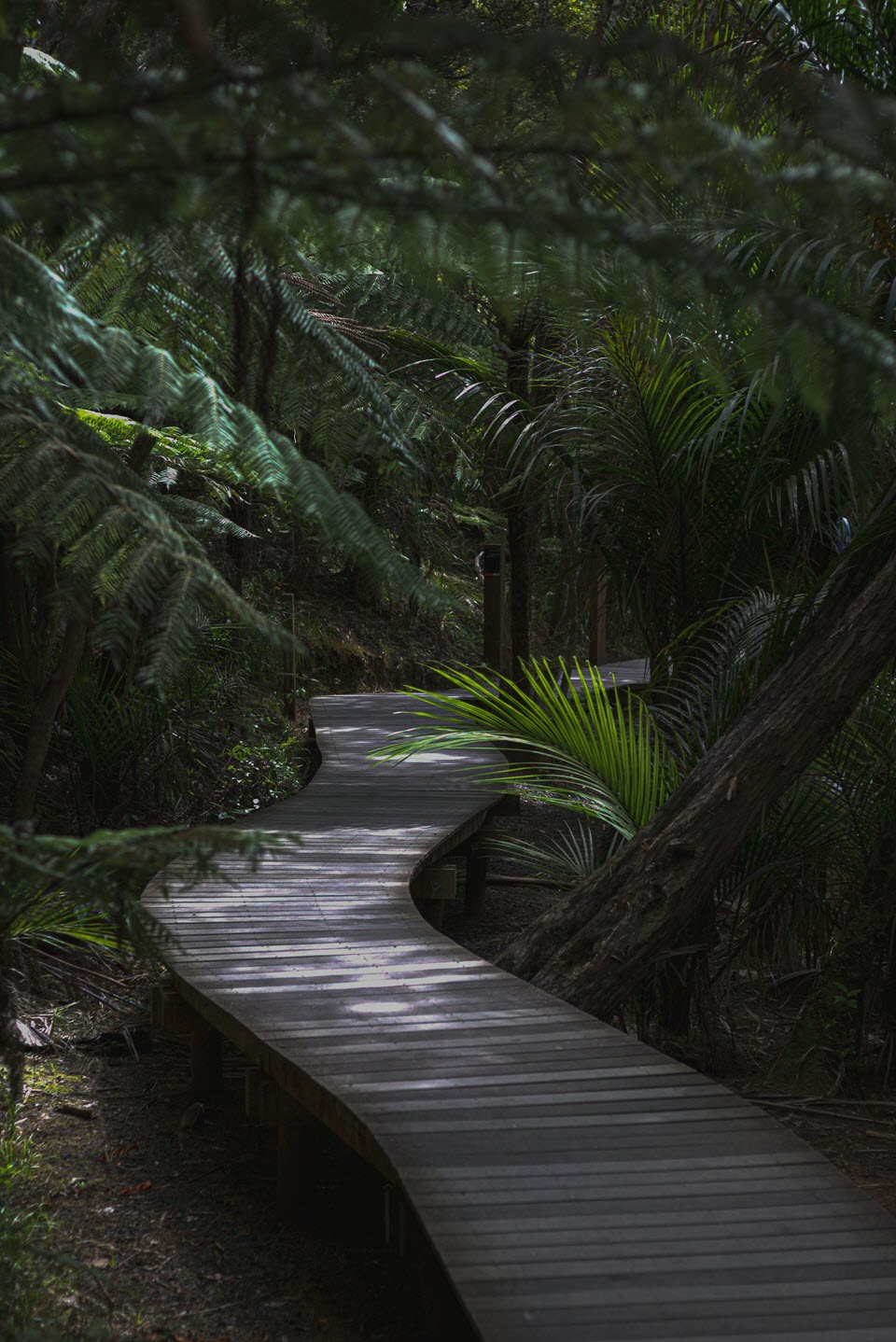
Kitekite Falls plunges roughly 40 meters in a series of cascades into a clear pool. It’s a refreshing spot where you can dip your toes (or take a quick swim on a hot day, as many locals do). The ambience is magical, you’re surrounded by dense ferns and native trees with the waterfall crashing into the pool. This hidden gem is often the highlight of Piha for those who venture beyond the beach.
Local tip: Go in the morning or on a weekday if possible. Kitekite is popular and the small parking area can fill up on sunny weekend. Also, avoid crossing the stream after heavy rain when water levels can surge.
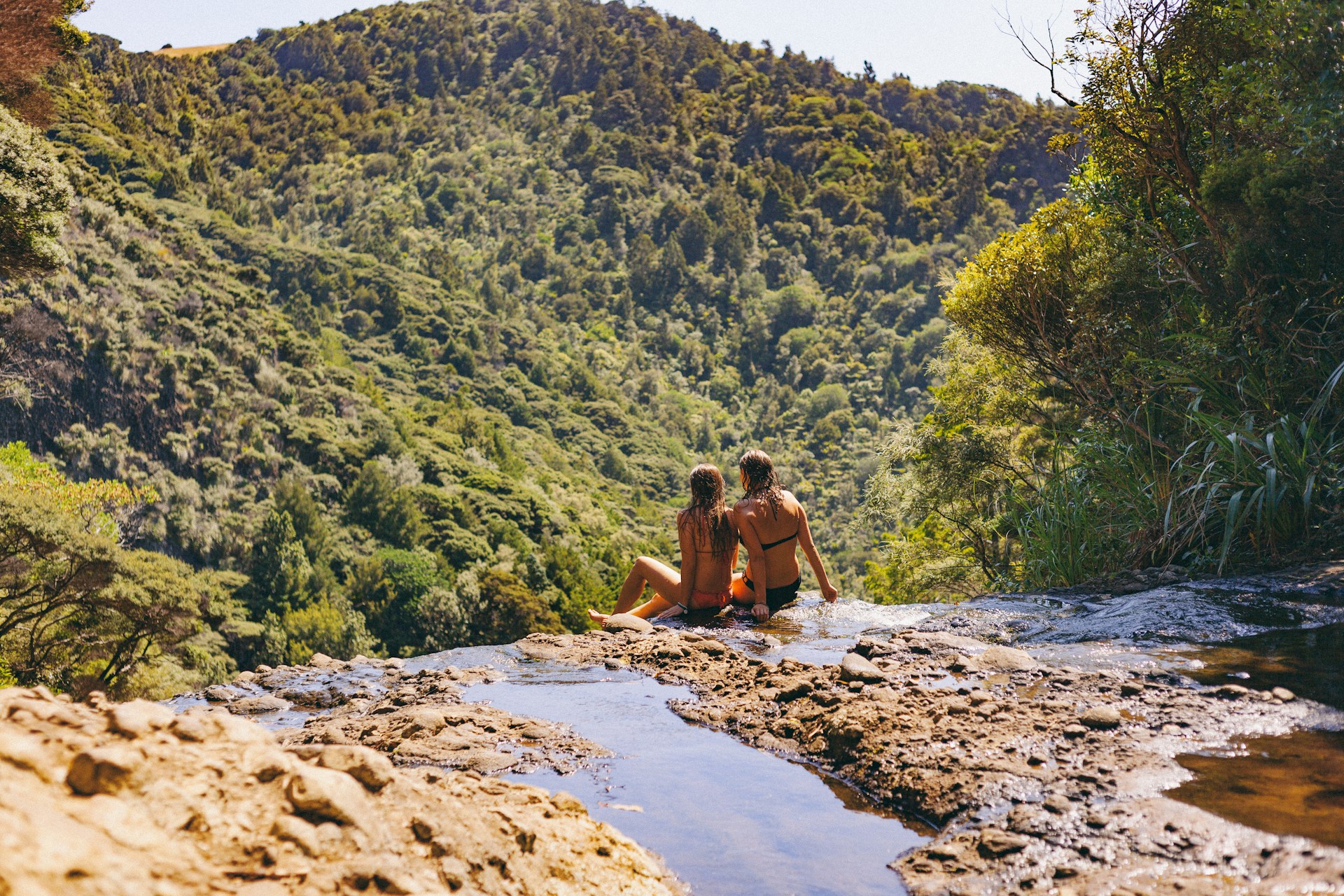
Back at Piha Beach itself, you can also take a short walk up Lion Rock partway for a panoramic view over the bay, a concrete staircase leads to a lookout on Lion Rock’s shoulder (the very summit is closed for safety). Another quick trail at the south end of the beach, the Tasman Lookout Track, yields fantastic views of Piha’s coastline and a glimpse of neighboring Karekare Beach to the south on clear days.
When you’ve worked up an appetite, Piha has a couple of casual eateries: a beachside café by the surf club for burgers or fish & chips, and a small general store for ice creams and basic supplies. Keep in mind this is a tiny community, so don’t expect big restaurants - the charm is in the natural setting. Enjoy a relaxed picnic if you brought one and soak in the wild atmosphere.
After experiencing Piha’s beauty - black sands, surf sprays, and maybe a waterfall shower – you’ll head north to the next destination. The drive from Piha to Muriwai Beach takes about an hour, traversing back through the forested hills and around the ranges. Aim to set off by mid-afternoon to catch Muriwai in time for the late-day light (and if you’re visiting in spring/summer, the gannet birds will be most active toward evening). Off we go to Muriwai, another jewel of Auckland’s west coast.
Muriwai Beach – Gannet Colony and Rugged Coastline
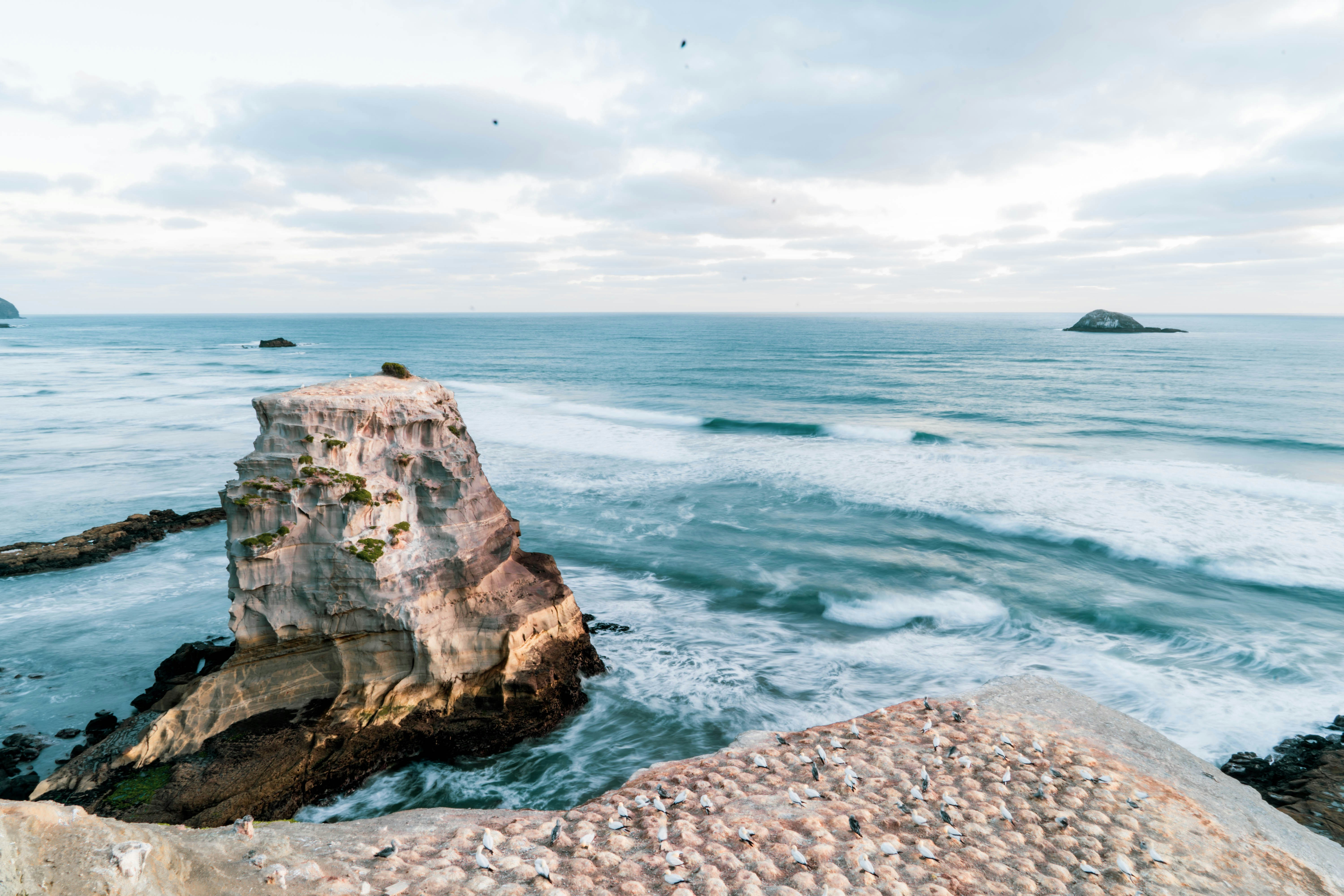
Muriwai Beach greets you with a vast expanse of black sand stretching as far as the eye can see, in fact, the beach extends about 60 kilometers up the coast to the north. This is a place where the Tasman Sea rolls in with pounding surf and the wind often whips along the dunes, giving Muriwai a wild, untamed feel. It’s only about a 45-minute drive from central Auckland (roughly the same as Piha) but feels a world away from city life. Muriwai is famous not just for its beach, but also for its spectacular gannet colony perched on the coastal cliffs.
From the main car park area, it’s an easy walk (around 5–10 minutes) along a well-formed path to reach a series of viewing platforms on the bluffs. Here, from August to March each year, you can witness the comings and goings of around 1,200 pairs of Australasian gannets nesting in tightly packed rows on the rocky outcrops. It’s a sensory spectacle, the sight of thousands of white seabirds with golden heads, the cacophony of their squawks, and yes, a bit of that seabird smell on the breeze! Watching the gannets swoop and glide on the updrafts is mesmerizing; with up to two-meter wingspans, they ride the air currents with masterful ease. If you’re lucky, you might see fuzzy chicks in the nests (eggs are typically laid around September, hatching in November). By April, the colony empties out as the young birds depart for Australia and adults migrate, so if you visit in winter (May–July), you won’t see gannets, but the lookouts still offer stunning coastal views and crashing waves for drama.
Even apart from the birds, Muriwai’s scenery is awe-inspiring. From the highest platform, you can gaze down along the coastline of endless black sand and towering dunes stretching north. Directly below, daredevil surfers often dot the water (Muriwai is another top surf spot, with a surf school if you fancy a lesson). To your right, the rugged cliff formations and offshore sea stacks (such as the famous Motutara Island where gannets nest) make for great photos, especially in late afternoon light. Stick to the fenced areas and designated paths, as the cliffs are high and can be unstable (heed any safety signs or closed areas).
Back near the parking area, Muriwai has a laid-back beach community vibe. There’s usually a food truck or the local café open for a coffee, ice cream or fish & chips, especially in summer. The beach itself at Muriwai is accessible for walking. You can stroll miles up the shore if you wish, feeling the coarse volcanic sand under your feet and the ocean spray on your face. Swimming here, like Piha, should only be done when lifeguards are on duty and in the patrolled zone, as rips are common.
Unique activities at Muriwai include beach horseback riding tours and even paragliding from the cliffs on windy days, if you’re feeling adventurous. But for most visitors, the combination of watching the gannets and enjoying a West Coast sunset over the sea is the ultimate highlight. Sunsets at Muriwai can be breathtaking - the sky turns vivid oranges and pinks reflecting on the wet black sand, while the silhouettes of gannets whirl above the crashing surf. It’s a picture-perfect ending to a day on Auckland’s wild west coast.
Walking Tracks and Nature in the Waitākere Ranges
While Piha and Muriwai are the headliners, the surrounding Waitākere Ranges deserve a special mention for nature lovers. This vast regional park encompasses 16,000 hectares of native rainforest and coastline, crisscrossed with trails ranging from short strolls to multi-day hikes. We’ve already covered the popular Kitekite Falls Track at Piha, but there are many other great walks if you have more time:
- Fairy Falls Track: Another beautiful waterfall walk in the Waitākere Ranges, located near Henderson Valley on the park’s eastern side. It’s a moderately challenging hike through dense bush to a series of cascading falls – well worth it for the tranquil forest scenes.
- Mercer Bay Loop: A short (45–60 min) coastal walk near Karekare with spectacular clifftop views of the Tasman Sea. This loop track takes you to the highest sea cliffs in the Auckland region - an epic vista and a bit of a hidden gem.
- Bush and Beach Tracks: The region is full of options, from the Beveridge Track near Arataki (an easy trail through native bush) to longer tramps like the Montana Heritage Trail. If you’re keen on hiking, consider spending an extra day to tackle more tracks. Always check the latest track status at Arataki Visitor Centre or Auckland Council’s website, as some trails periodically close for maintenance or kauri protection.
One special note: the kauri trees in these forests are ancient and iconic, but under threat from a soil-borne disease.
Do use the cleaning stations at trailheads to scrub and disinfect your shoes. It’s a simple step that helps save these majestic trees. Also, keep to the formed paths and avoid stepping on tree roots. By following these guidelines, you’ll ensure the Waitākere Ranges stay healthy and open for future visitors. Thanks :)
Tips for an Unforgettable West Coast Trip
To wrap up, here are some practical tips and final thoughts to make the most of your Piha-Muriwai adventure:
- Transport: The easiest way to do this circuit is by rental car or campervan. There’s no public transport to Piha or Muriwai, so driving yourself or joining a guided tour is best. The roads to Piha are winding and narrow, take it slowly and enjoy the scenery. (If you’d rather not drive, consider an organized day tour which often includes Arataki, Piha and sometimes Muriwai in one package.)
- Timing: You can technically see Arataki, Piha and Muriwai all in one long day, especially in summer when daylight is extended. Start early to maximize daylight. If you have two days, even better - you could dedicate one day to Piha and the Waitākere Ranges (with more hikes), and another to Muriwai and nearby attractions.
- What to Bring: Sturdy walking shoes (for bush tracks and clifftop paths), sunscreen and a hat (the UV sun can be strong even when it’s breezy), insect repellent for bush walks, and plenty of water. There are limited taps/shops once you’re out there. A light jacket is smart too as the weather on the coast can change quickly, and it gets cooler by late afternoon, especially if you’re staying for sunset.
- Safety: Always swim between the flags where lifeguards are present (typically summer only at Piha and Muriwai). If in doubt, don’t go out, both beaches have dangerous riptides. Observe all safety signage on tracks and cliffs (some areas can be closed due to erosion, especially after heavy rain). Cell phone reception can be patchy in the ranges and at Piha’s valley, so let someone know your plans if hiking and consider carrying a basic first aid kit for longer walks.
- Respect the Environment: These are wilderness areas, take any trash out with you, and don’t disturb wildlife. At Muriwai, keep a respectful distance from the gannets; do not cross fenced areas or try to get too close to nests (for both your safety and the birds). If you’re lucky enough to see other wildlife (sometimes you might spot fur seals or dolphins off Muriwai’s coast, or native birds in the bush), enjoy from afar.
By following these tips and the itinerary, you’re set for an incredible journey through Auckland’s west. From the moment you breathe in the fresh, rainforest-scented air at Arataki to the final sunset over the ocean at Muriwai, you’ll experience why this region is so special. It’s a side of Auckland that contrasts the urban bustle with raw natural beauty - and it’s highly likely to be a highlight of your New Zealand travels.
Haere mai ki te tai hauāuru - welcome to the west coast and have a fantastic trip! :)
